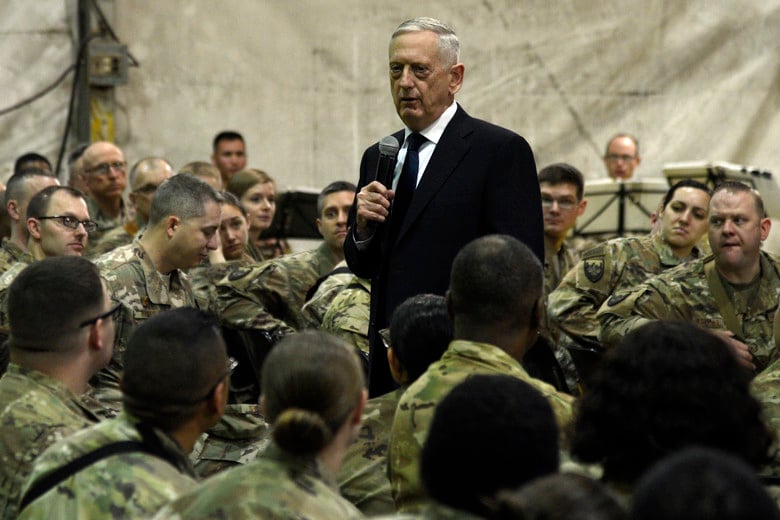WASHINGTON: Joining his boss, Jim Mattis, in revolt, Navy Secretary Richard Spencer publicly begged the White House not to cut $33 billion from the Pentagon’s defense request for 2020 as President Trump has ordered. With budget boosts since 2017 having restored frayed readiness and brought key modernization programs almost to the finish line, he said, “we’ve laid the foundation and spent this money to get us going in the right direction. The bicycle is up, we are pedaling; please don’t knock us over.”
“The waste would be absolutely stunning,” Spenser said at the Center for Strategic & International Studies this morning. To cut the already-completed 2020 budget plan so steeply on such little notice, he said, “some of the scenarios will make your eyes water for what we will have to do” in his shipbuilding and maintenance accounts.
Spencer, speaking at an event in Washington, said that the Navy was only now getting past some of the readiness issues that plagued it before a two-year, $165 billion deal was pushed through Congress in 2017 that gave the Pentagon temporary relief from budget caps.
Spencer’s plea came just two days after Defense Secretary James Mattis met with Trump at the White House alongside Senate and House Armed Services Committee Chairmen Jim Inhofe and Mac Thornberry to argue against the across-the-board cut, which they say would force a rethinking of the Pentagon’s defense strategy. It also follows weeks of public comments by Mattis and an increasingly restive congressional Republican caucus decrying the cuts, opening up the possibility of a rift developing between Trump — who has styled himself as the savior of the military — and his defense hawk constituency railing against the same kind of arbitrary budget slashing they say Congress just avoided.
A worrying sign for that group came on Monday, when Trump tweeted that this year’s $716 billion defense budget was “Crazy!”, strongly implying that the number should come down — albeit only if arms control negotiations succeed with China and Russia, a long shot at this point. Given the mercurial nature of this president, it’s unclear whether Trump will side with his budget hawk OMB director Mick Mulvaney in keeping the 5 percent cut or acknowledge the calls from the Hill and grow the budget by the previously planned amount.
Inhofe Objects
“I’m urging the president to consider” sticking with the Pentagon’s original $733 billion “strategy-driven budget,” Sen. Inhofe said Thursday in a speech at the National Defense University. There is “no strategic rationale for any cut” to the defense budget Inhofe said, placing himself squarely in opposition to the president, a surprising move for one of Trump’s most ardent supporters on Capitol Hill.
The House is also feeling restive. A group of 70 representatives led by Republican Mike Turner is preparing to send a letter to president Trump next week “strongly urging” him to stick with the $733 billion budget.
“President Trump cannot claim he is rebuilding our military while cutting the funds necessary to do so,” an initial draft of the letter reads. “We’ve seen the devastating effects on readiness when our military is forced to make arbitrary cuts as our adversaries continue to aggressively invest in their national security operations.”
On Tuesday, Mattis, Inhofe, and Thornberry huddled with Trump, Vice President Mike Pence, and National Security Advisor John Bolton at the White House, delivering the message that “the main thing is to make sure that we are going to be in a position to compete primarily with our peer competitors, and let me tell you, the president knows that,” Inhofe said.
Of course, Thornberry will no longer be House Armed Services chairman in the new year, giving way to Democrat Adam Smith, who’s repeatedly called for restraint in Pentagon spending. Inhofe, however, sounded one conciliatory, bipartisan note in a speech that slammed the Obama administration, liberals in general, and the media. Referencing a recent dustup between him and Rep. Smith over funding to modernize of the nuclear triad, Inhofe called him a “good man,” and said “I think it was a bad choice and I think it is one he and I can talk about. I think we’re going to see, even though Democrats have control of the House, when it gets down to defending America, we’re going to be much closer together.”
Mattis Speaks Out
While Inhofe and Thornberry hoped that their full-court press with Mattis might move the needle with the famously mercurial president, Mattis has kept the public pressure up. Speaking at the Reagan National Defense Forum this past weekend, the secretary said a $33 billion budget cut “would be a dangerous disservice to our troops and the American people they serve and protect,” while suggesting it isn’t a done deal.
“I would just tell you that the issue is in play,” Mattis said.
The Navy in particular is banking on growth in the defense budget to help it along the path of building a 355 ship fleet, while kicking of expensive modernization programs to arm of the nuclear triad, the $128 billion Columbia-class nuclear missile submarine program, and embarking on a plan to buy two aircraft carriers at a time.
Navy officials have said the decision on whether or not to seek to two-ship buy will be made by the end of this month.
The sea service has also had to dig itself out of a maintenance hole caused by repeated — and often extended — deployments in recent years which have worn down both hulls and crews.
Spencer said that he was “completely gobsmacked on how wide and how deep the readiness issue was. We’ve come to level ground on that.”
Alongside his pricey modernization programs and investing 15 percent of his budget on R&D, Spencer also said operational needs keep increasing from the need for an Arctic port in Alaska to beginning freedom of navigation patrols in the Arctic. “Everyone is up there but us,” he said. One navy official said earlier this week that it would cost $1.3 billion to return a Navy presence to Adak, an island off the Alaskan coast.
Senate passes $95 billion foreign aid bill, as DoD eyes next Ukraine weapons package
Additional aid for Ukraine could be made available “within days” said Pentagon Press Secretary Maj. Gen. Pat Ryder earlier today.






























